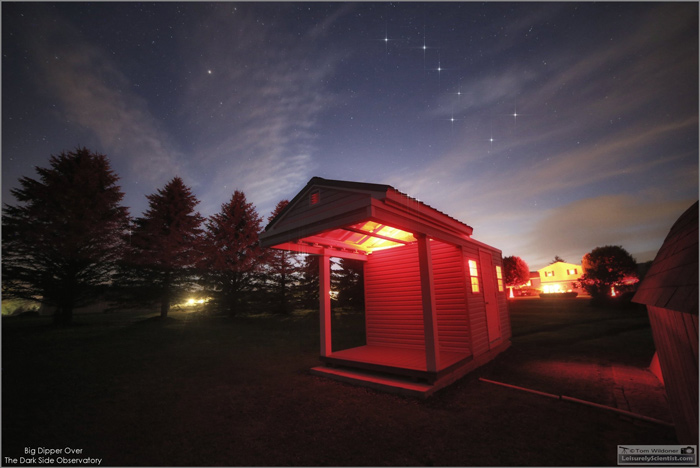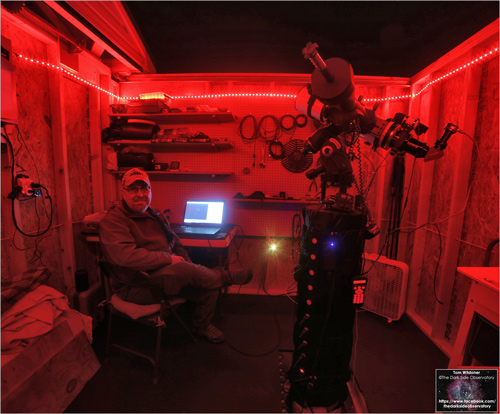A Q&A with Amateur Astronomer Tom Wildoner
Overview
Tom Wildoner is a photographer and amateur astronomer based in eastern Pennsylvania. Recently retired, Tom spends his time hiking, relaxing, and enjoying the natural world, and he observes and images the night sky from his Dark Side Observatory. He recently took the time to answer a few questions about his experiences and interests as a long-time amateur astronomer, and reveals an intriguing low-tech trick for achieving ‘diffraction spikes' in star images. Read our Q&A below...
Astronomy Connect (AC): How long have you been a stargazer, and what inspired you to get into stargazing??
Tom Wildoner (TW): I've been interested in astronomy since my first serious science class in 7th grade, a long time ago in 1974! After we finished our first class on astronomy, I was hooked. I started keeping a journal soon after, documenting my observations over the last 45 years.
AC: What was your first telescope? Do you still have it?
TW: My grandfather purchased my first telescope for me, it was a Tasco 2¼" refractor. Amazingly, I used that telescope over the next 15+ years until I gave it to my nephew when he developed an interest in astronomy.
AC: Are you mostly a visual observer, or are you an imager?
TW: In the early days, I was a visual observer only. There were no digital cameras, only film. I had an interest in photography in high school, which naturally made me want to photograph the sky as well. Today, I am pretty much an imager only.
 Figure 2 - The Big Dipper over the Dark Sky Observatory
Figure 2 - The Big Dipper over the Dark Sky ObservatoryAC: Where do you do most of your observing these days?
TW: Most of my observing and photography is done from my observatory, The Dark Side Observatory, in Weatherly, Pennsylvania.
AC: How do you usually plan a night's observing??
TW: I use a few different tools including two software packages, Starry Night Pro and Stellarium, to see what areas of interest are overhead. I then keep a Google Sheet with all the deep sky objects I have imaged and those that require additional time.
AC: What's your favorite odd-ball astronomy accessory/device for visual observing or imaging?
TW: The strangest thing in my arsenal are two pieces of fishing line and a rubber band. Before there were filters and software techniques to add diffraction spikes to images, I would place the fishing lines across the front of my lens, holding them in place with a rubber band. This would provide "star spikes" on the captured image. To this day, I still use the fishing line trick on occasion.
 Figure 3 - The Dumbbell Nebula, M27, imaged by Tom Wildoner
Figure 3 - The Dumbbell Nebula, M27, imaged by Tom WildonerAC: What's your favorite type of object to observe or image?
TW: I do not know why, but I do like to image globular clusters. Some are very challenging such as the Palomar Objects. They have always intrigued me. The Hercules Cluster (Messier 13) was also one of the first deep sky objects I observed through my first scope.
AC: Can you share one of your most memorable experiences as a stargazer?
TW: I can remember it as if it has just happened, my first digital image of Messier 13. I only got back into astronomy seriously since 2011, with the purchase of my Meade 12" LX-90 telescope. I still remember taking that first digital photo using a Canon T3i and seeing resolved stars in a globular cluster for the first time!
AC: I understand you're retired now, but what did you do in your non-stargazing life?
TW: I did environmental work for the Department of the Army for 35 years and spent four years as an Officer in the U.S. Army Chemical Corps. This included managing drinking water and sewage system, computer automation, Geographic Information Systems (GIS), weather towers, and much more.
AC: Have you got one or two tips for beginning stargazers?
TW: I'll pass this tip on from my wife: if you plan on buying astronomical equipment, do your research and buy the best, first. It may be hard to do, requiring additional saving and waiting, but you will save money in the long run. On several occasions I have purchased three or four mid-range items, and finally purchasing the "higher end" equipment last. Needless to say, I could have saved a lot of money just purchasing the better item up front.
On an another note, keep a handwritten journal. You'll find yourself referencing your own work 20 to 30 years down the road and giggling about it. I do that to this day, still go back and look at my entries from the 1970's.
AC: Professional astronomy seems to be in a golden age. But does it seem to you that amateur stargazers are on balance getting older, with fewer younger people taking up the pastime these days? If so, what can be done about this?
TW: From my perspective, I do see younger people showing an interest in astronomy from an imaging perspective. They like the "cool" pictures and being able to share and comment on them using Social Media outlets. However, I do not see many young people taking a bigger step into the hobby.
What I have done to help get them interested is donate my time to local schools to give presentations on astronomy and astrophotography, especially if the schools also have a camera club. I have also partnered with a local library (Dimmick Memorial Library, Jim Thorpe, PA) to do a monthly free presentation called "Looking Up - Your Guide to the Night Sky for the Next 30-Days". Hopefully the presentation will help get the young adults outside and looking up.
AC: Where can we see more of your work and follow your astronomy activities?
TW: My web-based media locations are:
- FACEBOOK https://www.facebook.com/tom.wildoner
- FACEBOOK https://www.facebook.com/thedarksideobservatory/
- INSTAGRAM tomwildoner
- TWITTER @TDS_Observatory
- REDDIT leisurelyscientist
- FLICKR https://www.flickr.com/photos/tomwildoner
***
This article is © AstronomyConnect 2019. All rights reserved.
Please login or register to watch, comment, or like this article.PXR-5 likes this.
-
Final Announcement: We're Saying Goodbye to AstronomyConnect. Read Our Closing Notice.
Dismiss Notice
New Cookie Policy
On May 24, 2018, we published revised versions of our Terms and Rules and Cookie Policy. Your use of AstronomyConnect.com’s services is subject to these revised terms.


